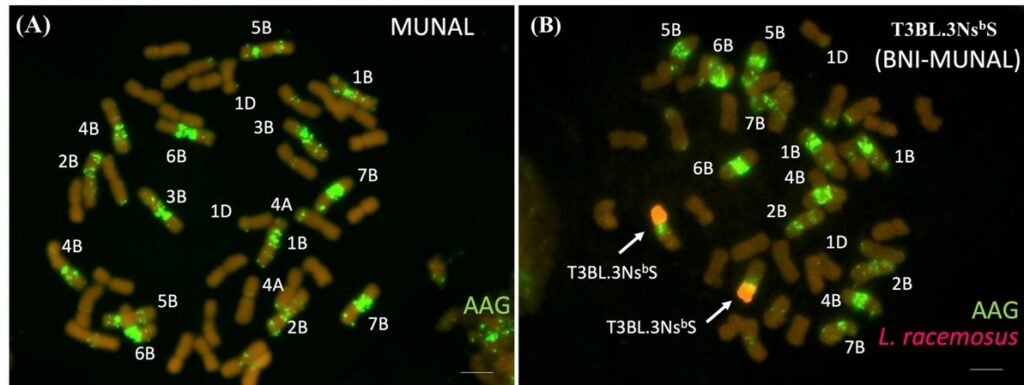The discovery of a grass that makes its own antibiotics may have wide-reaching implications for restoring soil health and improving water quality. Tech Farmer considers the implications of the trait for UK wheats.
There’s a type of grass that thrives in the tropical pastures of Colombia that confounded scientists for decades. Brachiaria has been dubbed as a ‘wonder grass’ for its ability to grow in soil that has negligible mineral nitrogen, and no means to sequester it.
Scientists at the Japan International Research Center for Agricultural Sciences (JIRCAS), led by Dr Guntur Subbarao, unlocked the secrets to this remarkable biological phenomenon. Now they’ve bred this ability into modern wheats – high-yielding elite wheat lines are currently in the field that produce the same yield and quality as their parent control with 40-50% lower nitrogen inputs.
They’ve also shown there’s a staggering potential for these curious crops to reduce massively the estimated 70% of nitrogen lost from soils and washed into the world’s waterways. Most of this is applied as synthetic fertiliser – a global consumption of 150M tonnes that’s responsible for 5% of total greenhouse gas emissions.

What’s more, according to Guntur, farmlands are increasingly leaking out this overapplication of fertiliser. “They’re leaking nitrogen uncontrollably. And if you can’t keep nitrogen in soil you can’t keep the carbon in either,” he says.
So what is the secret to keeping nitrogen from being leaked out? Guntur explains it comes down to “a little bacteria” that lives in the soil and eats ammonium, that binds to soil particles, and excrete as nitrates by-product. “Many plants can use nitrates as a nitrogen source, but nitrates require more metabolic energy to assimilate, thus expensive for plants to metabolize compared to ammonium. In addition, another major problem is that nitrates cannot bind to the soil and wash out.”
The Green Revolution, while it transformed global food grain production, has brought about a 30-fold increase in nitrogen fertiliser consumption. This, he says, has disrupted the complex microbial networks in the soil and changed their population dynamics. “These little bacteria that used to perform a small, subdued microbial activity, have grown now into a monster. It’s consuming nearly 95-99% of the fertiliser nitrogen and spitting it out into harmful nitrates and nitrous oxide (N₂O) gas. We should question whether we are applying nitrogen fertilisers to feed crops or to nurture this monstrous nitrogen-eating bacteria.”
The plants learn to use every picogram of N that’s available.
Guntur believes this has made soils of the modern farming systems increasingly sick. “When you are sick, you take antibiotics. And that is what we discovered about Brachiaria. It produces large amounts of antibiotics from its root systems. These antibiotics tightly control the nitrifying bacteria. It doesn’t kill the bacteria, but just keeps them in a kind of coma state.”
What the team at JIRCAS realised was that this natural Biological Nitrification Inhibition (BNI) allowed plant roots to moderate the conversion of N in the soil precisely to its needs. “The plants learn to use every picogram of N that’s available.”
The concept was introduced in 2006. “At first no one believed us – the plant-nutrition community tried to shut us down. We had to prove certain plants were exhibiting BNI,” recalls Guntur.

“The big breakthrough came when we developed an assay that detected the presence of BNI. That allowed us to really understand the phenomenon – what controls it, how it is regulated and what makes it effective and stable in soil systems. We published what became a landmark paper in PNAS (Proceedings of the National Academy of Sciences of the USA) during 2009.”
But then the funding for the research program came under threat. “So we set about exploring important staple crops such as sorghum, wheat, and maize for a BNI trait.”
The function was detected and characterised in sorghum in 2011. But the big goal was wheat and maize as they consume nearly 50% of the nitrogen fertilisers applied to farmlands globally. “We worked with commercial wheat lines from across the world, but couldn’t find a single one that had a significant BNI capacity.”
Eventually the team found two wild wheats with the BNI trait – Leymus racemosus and Leymus mollis. “We identified the chromosome arm that carried the trait – 3NsbS – and successfully transferred this into a modern Mexican wheat, Munal, in 2021.”

And with this came another big breakthrough. “We thought the entire elite agronomic architecture of the crop would change, that we would need decades of backcrossing to take out undesirable traits from wild wheat that we’d introduced. But to our amazement, there were no detectable differences, apart from a high level of production of BNI. We even checked the production of bread-making quality.”
This discovery has profound implications – it meant the trait can now be safely crossed into any modern wheat lines, without the need for genetic modification nor any novel genetics. To date there are five wheat lines that carry the BNI trait, including Borlaug 100, an elite-wheat variety from Mexico’s International Maize and Wheat Improvement Center, CIMMYT, which has spearheaded the Green Revolution by developing high-yielding semi-dwarf fertilizer-responsive wheat varieties.
But Guntur believes the potential for the BNI wheats goes much further. Studies indicate BNI wheats not only suppress nitrification potential, but also reduce N₂O emissions, a major greenhouse gas emitted from farmlands. In addition, they alter N metabolism to improve its use efficiency in the plant and raise N uptake from soil organic matter under low N conditions.
“They perform in both high and low-fertility situations and in a few years from now, will be available to all farmers. Our hope is that in the next 10 years, most of the wheats grown in different parts of the world would have this ability built in as a core trait,” he says.
“These large amounts of antibiotics from wheat root systems will bring a natural control to nitrifying bacteria and reduce the amount of nitrogen fertiliser applied in future. It’ll improve the health of our soils, the state of our waters, and stop so much fertiliser going to waste.”

UK introductions
Discussions are currently underway to bring the BNI wheats into studies at the John Innes Centre, Norwich, presenting the prospect of introducing the traits into UK commercial lines.
But they’re not the only wheats that exhibit this curious ability to suppress the activity of nitrifying communities within the soil microbiome. Work has been ongoing as part of the WISH-roots project (Wheat Roots Improving Soil Health) to investigate cultivars with unusual rooting ability. Two in particular have been identified with nitrification potential and will be brought into farmers’ fields for testing in a commercial setting.
The project is a three-year programme of work involving a consortium of seven research institutes across Europe, China and South Africa. The aim is to explore the ability of the wheat roots to control the soil microbiome to improve soil health and optimise rhizosphere nitrogen cycling and availability.
“Modern wheat varieties seem to have lost the capacity to control nitrification,” notes Dr Maria Hernandez-Soriano, who leads the JIC team on the project. Field trials have been exploring the attributes of ten landrace varieties from the Watkins collection, along with ten durum wheats. “We’ve selected these Watkins wheats because previous studies have shown they are good at controlling nitrogen transformation in the soil.”
The wheats have come from a collection of 826 cultivars, collected from over 32 countries around 100 years ago by AE Watkins,a civil servant who worked with the board of Trade in London . The collection is now looked after at JIC and their phenotypic traits and genomes are being explored through a number of ongoing projects.
“We’ve been studying rhizosphere soil samples collected from the 20 cultivars and analysed these for microbiome composition, using DNA sequencing, and potential nitrification rate using a novel nitrate-selective sensor.”
Maria’s been looking closely at the activity of two of the most prevalent nitrifying communities, Nitrososphaera and Nitroscosmicus archaea. These have become the biomarkers in the rhizosphere of modern cultivars following N-fertiliser application, to the detriment of other communities.
“The abundance of these microbes in soil dramatically increases when you apply ammonium-based fertilizers, rapidly turning ammonium into nitrate, which is highly soluble and easily lost to the environment through leaching or gas emission as nitrous oxide,” explains Maria.

“We’ve narrowed down ten Watkins lines that react to the application of the fertiliser. They immediately control the microbes and slow down that transformation.
“We have found higher N availability for plants and lower N microbial consumption in the rhizosphere soil across those Watkins lines, compared with modern wheat varieties. Two lines in particular stand out – Watkins 238 and 580.”
These two lines are now being multiplied up as part of a separate, £1M Defra-funded project led by the British On-Farm Innovation Network (BOFIN). TRUTH (Thriving Roots Underpin Total soil Health) is a three-year project during which farmers are work with scientists to understand soil and root health and improve crop productivity. On-farm trials will be carried out by Root Rangers, up to 30 progressive UK growers. They will receive training to study and sample wheat roots, with rhizosphere samples sent to JIC for DNA analysis.
“In the final year of the project, for 2026 harvest, the Root Rangers will each get the opportunity to grow one or both of the Watkins lines to see for themselves how they perform next to their farm-standard wheat. They’ll also study the effect on the rhizosphere of nitrogen application, to see for themselves the activity of the nitrifying communities and how the Watkins lines suppress it,” she says.
Previous trials at JIC have identified several quantitative trait loci (QTLs) or areas of the wheat genome responsible for the nitrification inhibition trait using crosses of Paragon and Watkins 238. The next step is for breeders is to incorporate this trait into current elite varieties.
“These wheats definitely have the potential to make a huge improvement to nitrogen use efficiency. The plant will regulate better fertiliser transformation and uptake and have more time to use it, rather than having these inefficient spikes. That could also mean a decrease in the amount of fertiliser applied and less losses to the environment – it’s a win on many levels,” concludes Maria.
The first half of the article on the work of Dr Guntur Subbarao at JIRCAS, was first published in Views on Agriculture, www.viewson.ag.
For more information on TRUTH, go to www.truthproject.uk




